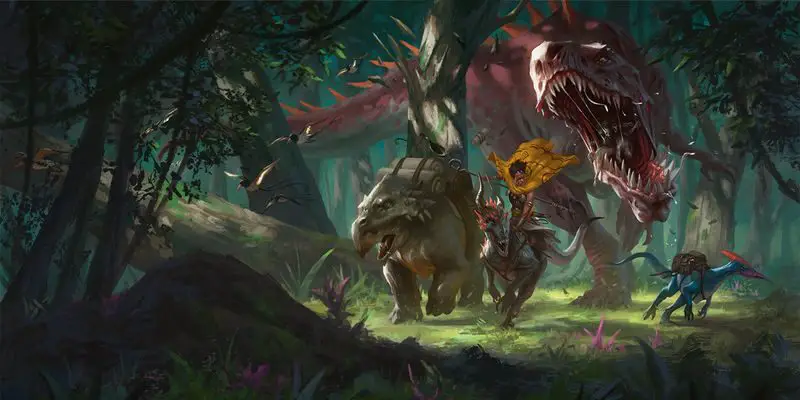Featured image by TomTC, Creative Commons Attribution-Noncommercial-No Derivative Works 3.0 License
It comes as no surprise that Dungeon Masters wear many hats: actor, world builder, game coordinator, Master of Ceremonies. Perhaps their greatest role is storyteller, for without a tale, the game is simply a static battle arena.
Dungeon Masters have many tools at their disposal to engage their players in rich storytelling. In this article, we will explore the underutilized device of dream sequences and how to effectively use them in-game.
Purposes of a Dream Sequence
In literature, dreams have been used to serve many purposes. In the Iliad, Zeus implants a false dream in Agamemnon to persuade him to attack Troy; in the New Testament, Matthew uses visions as a textual device to convince readers to become disciples; author Robert Jordan uses dream sequences in the Wheel of Time series to foretell future events with ambiguous imagery.
Dungeon Masters may use dreams to fulfill similar objectives:
- To forewarn a player of a lurking danger
- To entice players to follow a specific path (start a quest, make a choice)
- To allude to their forthcoming fate based on their recent choices
- To inform players of the nature of an NPC (sow trust or wariness)
- To foreshadow the overarching plot of the campaign
- To give a player guidance from their deity
- To inspire a player to character development
- To recall a backstory memory that may influence a players’ future decisions
- To open a player to boons, additional abilities, and unrealized powers
- To role play or give flavor to leveling up
- To fill in gaps in player memory (a piece of information from an NPC conversation)
- To give players a sense of dread about a villain they are unprepared to face
- To reorient a player to their alignment
- To introduce soon-to-be NPC’s
- To flesh out characters’ backstories
- To interact with a rival or villain (think Kylo Ren’s and Rey’s connection)
Setting Up the Dream
There are two options in how to portray dreams in a campaign: as a narrative passively witnessed by the dreamer (or dreamers if multiple characters share the dream), or as an experience to interact with. Both options have their place in storytelling: the first option is easier to employ, and is more straightforward for getting a point across; the second option, though more difficult to strategize, allows for impactful interaction that players will not likely forget.
Passive Dreams
In showing passive dreams, a Dungeon Master has many methods at their disposal to get a point across.
Visions of the Present: Show scenes from people, places, or things in the actual campaign setting to paint a clear picture for your players. Perhaps your player sees an NPC she connected with dying of a terrible disease in the night, or your player is transported onto a misty mountain top where he sees an evil NPC hammering a large black sword (and the NPC sees your player, too, to add a bit of dread). Send a message with asides of adjacent happenings in the world.
Visions of the Past: Reveal insight into the present and future through the witness of past events. The Wheel of Time series, book 4, does an excellent job of this, where the main character sees through the eyes of his ancestors, witnessing events that occurred that explain the lore of his current world and give direction to his future actions.
Allegorical Story: This approach is most accurate to actual dreams, where a story takes place, involving the character or not. This method includes a “surface story” and a story beneath with meaning. These stories may be very subtle and short, like a metaphor, such as imagery of a bird kicking one bird out of its nest, to symbolize colonization, or two different species of birds fighting each other to symbolize an upcoming war. Or, the dream sequence could be a more involved saga, spanning over several long rests, involving previously unheard-of characters in their adventures.
Flashbacks: Remind players of recent events to reframe their current or upcoming decisions. Perhaps a player was shown grace by a person of power and may need to passalong that grace to someone who will soon or has recently wronged them. Flashbacks can also remind players of important NPCs and events from their backstory (even if the DM has to take liberties with this).
Foreshadowing: A Dungeon Master can foreshadow upcoming events or possible outcomes—explicitly or indirectly. Combine this method with allegory for a subtle tone of foreboding, or show a myriad of potential aftermaths to make the players think on their decisions.
Juxtaposition: Show two very contrasting scenes side-by-side or one after the other to elicit an emotional response from players. Show scenes of great violence, turmoil, and suffering, immediately followed by imagery of redemption, salvation, and growth (or vice versa!). Or, use this tool to express the dichotomy of a character’s mind, torn between serving their deity and their moral conscience.
Tone: You can set the tone with vague dreams that don’t have explicit meanings by describing symbols and imagery. Explain to a player a disturbing dream unrelated to current events to set a tone of general ominousness, or tell of a dream of a comforting reunion with deceased loved ones after a player blunders and causes an unfortunate event.
Interactive Dreams
Allowing your players to be involved with their dreams opens doors to different opportunities.
Dreams as a Trial: Because a player is conscious of what they are doing, interactive dreams are more reflective of a character’s internal integrity and decision-making. Allow players to react in situations without consequence before they have to experience similar conflict in their “real world,” such as battle strategies or influencing NPC’s. Show the catastrophic effects and where your players erred. Or, if someone acts in a dream counter to their integrity or alignment, when they’re out of the dream, ask them how their character feels about the dream choices, and remind them of this in-game when appropriate (“you recall how you hurt that child in your dream and feel queasy in your stomach.”).
Dreams as Redemption or Condemnation: Perhaps a player feels horribly that they allowed someone to suffer or even die. Have a player role play with this NPC in-dream to bring closure, resolution, and redemption. This can inspire major character development in your campaign. Or, make a player feel guilty for the wrong that they have done by interacting with the family of those they have killed, or seeing the consequences of the world as a result of their actions (antithesis to “What a Wonderful Life”).
Introduce a Villain in Dreams: Have a big bad boss meet a player in their dreams and interact. Perhaps a player comes to understand the villain’s motives better (he has what he believes are righteous motives!), or perhaps a player realizes a villain’s power and their own unpreparedness. Or, give players insight into some weakness of the villain through their own cunningness and discovery.
Fast Forward Exploration through Dreams: Another method used well in the Wheel of Time series is exploring the world in a dream. Let each step be a five-mile progression, so land can be covered very quickly. Perhaps players seek an item, or look for a kidnapped victim. To skip a lot of investigation and exploration, allow this to be done in a dream at five times speed. Or, drop a dreaming character in a new location where they can seek that which is lost. They can find it within minutes, and this will give your party a new direction in the campaign.
Play through Secondary Stories in Dreams: Throw characters into the bodies of new faces and allow players to temporarily take on new roles. Allow them to interact with the past, or another situation in the present, through the eyes of people they’ve never met. An invested Dungeon Master might even create simple character sheets for these new adventurers and resume portions of the dream sequence in subsequent sessions.
Tips for Dream Sequences
Dreams can be a force of plot advancement and character development, or they can flounder and feel like a waste of time, or a punishment. Here are some tips for how to develop your dream sequences for maximum player enjoyment.
Let Characters Long Rest. It may be tempting to rob your players of long-rest benefits, or to penalize them with exhaustion, like the effects of the Dream spell. This method may have its place at times, but doing so frequently will irritate your players and may lessen the effect of your storytelling efforts. Decide beforehand the purpose of your dream and if consequences fulfill that purpose.
Give Fair Consequences. Along the same lines, it’s not always prudent to punish your players for what they do in dreams, but give them a reminder that their actions and intentions matter. If a player casts level 9 meteor storm in the dream, don’t remove that spell slot for the day, but make it apparent a sheer lack of wildlife around, and describe broken trees and split logs. If a player commits a heinous crime in the dream, let that haunt them throughout the game.
Make Players Think. Dreams don’t have to make sense, they just need to make players think. However, if a dream is too bizarre, it may be completely dismissed. Make the dream sequences understandable and somewhat relatable, if not entirely clear in its message.
Don’t Railroad Interactive Dreams: What would be the point of allowing a player to interact with their dream, only to find they are bound to one particular course of action? It would be better to experience a passive dream at this point. Instead, leave interactive dreams open-ended, and let players’ actions matter. This also means that you need to prepare contingencies for getting your point across in the event that a player derails your dream plans.
Make Dreams Relevant but Not Critical: If the dream plan does go awry, and your message was not adequately conveyed, this should not ruin the plans you have for your campaign. Therefore, don’t make your dreams vital to your plot, but still make them worthwhile for player time.
Give Red Herrings Cautiously: To pull off giving red herrings, the method needs to make sense in-game with real mechanics. False dreams may be infuriating to players if they, after discovering the ruse, don’t understand that a villain implanted a dream or extracted a memory through legitimate game mechanics. Afterall, the Dungeon Master isn’t the villain and shouldn’t mislead players. Leave that to in-game methods.
Reward Courage: Sometimes, a player needs to be rewarded for making a hard choice. Allow a deity to bestow a boon or magic item on the character for their bravery, or give advantage due to their good choices.
In-Game Mechanics: Spells, Monsters, and Dreamscapes
In terms of in-game mechanics that involve dreams, there are a myriad of spells that might affect a characters’ dreams. Plan real-stakes psychic battles with the Dream spell (see our Dream spell article for ideas on using this spell creatively); send messages to characters via spell-casting NPCs to discuss something vital in-dream; hold players captive in Dreamscapes through monsters like night hags, aboleths, mindflayers, vampires, succubi, or evil wizards. Beholder dreams shape reality; creatures and people such as the Githyanki can walk the astral plane; and some class archetypes like Druid Circle of Dreams give flavor to those who can affect dreams.
With all of these tools, a Dungeon Master can find ways to make dreams and reality one in the same.
What are some ways you have used dreams in your campaigns? Do you have a favorite method of employing nighttime visions? We’d love to hear your thoughts!




